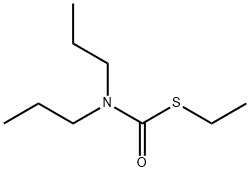S-에틸 디프로필티오카바민산 C화학적 특성, 용도, 생산
화학적 성질
Light yellow liquid or yellow granular material.
Commercial products may be in the form of dusts, sprays,
solutions, wettable powder suspensions or emulsions.
용도
A preemergence herbicide.
일반 설명
S-Ethyl dipropylthiocarbamate (EPTC) is a pale to dark yellow liquid with an aromatic odour/pleasant scent characteristic to thiocarbamates. EPTC is a commonly used herbicide. EPTC has a pleasant scent and at 20°C is miscible with most organic solvents, including acetone, ethyl alcohol, kerosene, methyl isobutyl ketone (MIBK), and xylene.
EPTC was the first thiocarbamate herbicide developed. EPTC formulations are used for the control of preemergent weeds, especially grasses. EPTC inhibits photosynthesis, respiration, and the synthesis of lipids, proteins, and RNA in these seedlings. Resistant plants are less sensitive to the herbicidal action apparently due to their ability to rapidly metabolise EPTC.
공기와 물의 반응
Water insoluble. Slowly decomposes in water to form carbon disulfide and propyl amine. Such decompositions are accelerated by acids.
반응 프로필
Eradicane may generate flammable gases with aldehydes, nitrides, and hydrides. Incompatible with acids, peroxides, and acid halides.
건강위험
SYMPTOMS: Symptoms of exposure to Eradicane may include headache, giddiness, nervousness, blurred vision, weakness, nausea, cramps, diarrhea, sweating, miosis, tearing, salivation, vomiting and cyanosis.
화재위험
Flash point data are not available for Eradicane, but Eradicane is probably combustible.
농업용
Herbicide: Some formulations are Restricted Group Pesticides
(RUP). EPTC is a pre-emergence and early post-emergence
herbicide used to control the growth of germinating annual
weeds, including broadleaves, grasses, and sedges. It is
used in every region of the United States in the production
of a wide variety of food crops. The heaviest usage is in the
Corn Belt, Northeastern and Mid-Atlantic states, Coastal
and Northern Great Plains and in the Pacific Northwest on corn, potatoes, sweet potatoes, dry beans, peas, alfalfa, and
snap beans. EPTC is also used on home-grown vegetables
and ornamentals. Not approved for use in EU countries.
Registered for use in the U.S. and other countries
상품명
ALIROX®; EPTAM®; EPTAM® 6E;
EPTAM 2.3G (granular, 2.3% by weight); EPTAM 10G
(granular, 10% by weight); ERADICANE®; GENEP®
EPTC; R-1608®; SHORTSTOP®; STAUFFER® R 1608;
TORBIN®
Safety Profile
Poison by ingestion,
inhalation, and intravenous routes.
Moderately toxic by skin contact route.
Mutation data reported. An herbicide. When
heated to decomposition it emits very toxic
fumes of NOx and SOx. See also
CARBAMATES
잠재적 노출
EPTC is a pre-emergence and early
postemergence thiocarbamate herbicide used to control the
growth of germinating annual weeds, including broadleaves, grasses, and sedges. It is used in every region of the
United States in the production of a wide variety of food
crops. The heaviest usage is in the Corn Belt, Northeastern
and Mid-Atlantic states, Coastal and Northern Great Plains
and in the Pacific Northwest on corn, potatoes, sweet potatoes, dry beans, peas, alfalfa, and snap beans. EPTC is also
used on home-grown vegetables and ornamentals. Some
formulations are Restricted Group Pesticides (RUP)
신진 대사 경로
A new class of xenobiotic metabolite derived from the
glutathione conjugate is produced by corn, cotton, and
corn cell suspension cultures treated with 14C-EPTC
(S-ethyl dipropylthiocarbamate). This metabolite is
characterized as S-(N,N-dipropylcarbamoyl)-O-
malonyl-3-thiolactic acid and is not detected in
soybean plants or peanut cell suspension cultures. A
second major metabolite of EPTC, S-(N,N-
dipropylcarbamoyl)-N-malonylcysteine, is present in all
tissues.
운송 방법
UN2902 Pesticides, liquid, toxic, n.o.s., Hazard
Class: 6.1; Labels: 6.1-Poisonous materials, Technical
Name Required
비 호환성
Thiocarbamate esters are combustible.
They react violently with powerful oxidizers such as calcium hypochlorite. Thermal decomposition of thiocarbamate compounds include carbon disulfide, oxides of sulfur,
oxides of nitrogen, hydrogen sulfide, ammonia, andmethylamine. Thio and dithiocarbamates slowly decompose
in aqueous solution to form carbon disulfide and methylamine or other amines. Such decompositions are accelerated by acids. Flammable gases are generated by the
combination of thiocarbamates with aldehydes, nitrides,
and hydrides. Thiocarbamates are incompatible with acids,
peroxides, and acid halides.
폐기물 처리
Land burial is acceptable for
small quantities. Larger quantities can be incinerated. (EPTC
is combustible and could be incinerated. Recommendable
method: Incineration. Peer-review: Incineration in a unit witheffluent gas scrubbing is recommendable for large amount.
Containers must be disposed of properly by following package label directions or by contacting your local or federal
environmental control agency, or by contacting your regional
EPA office. Consult with environmental regulatory agencies
for guidance on acceptable disposal practices. Generators of
waste containing this contaminant (≥100 kg/mo) must conform with EPA regulations governing storage, transportation,
treatment, and waste disposal
S-에틸 디프로필티오카바민산 준비 용품 및 원자재
원자재
준비 용품








